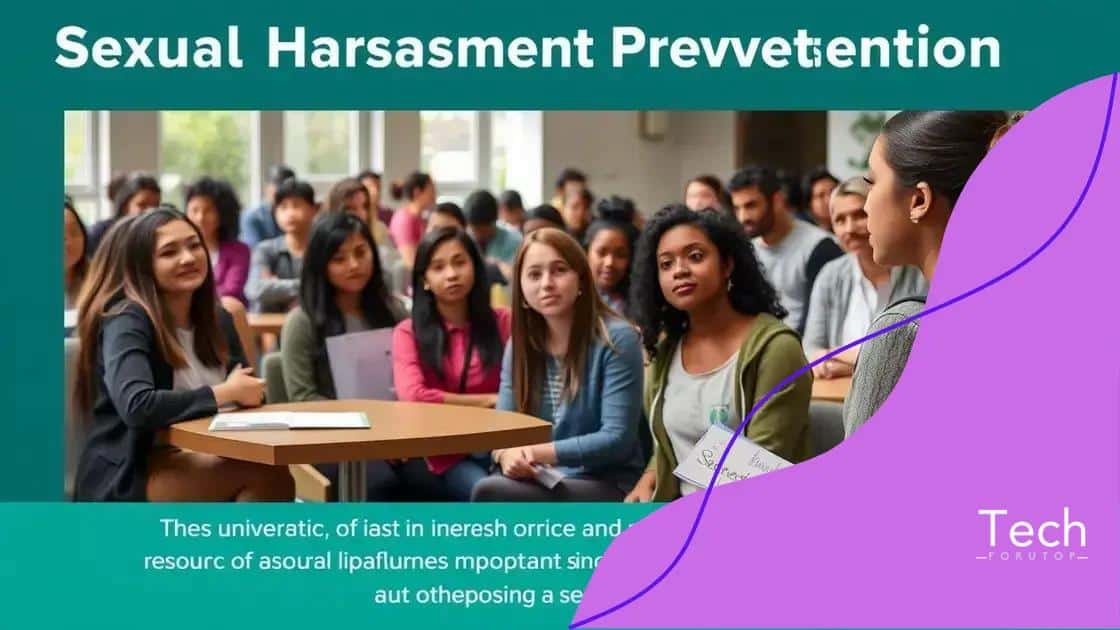Higher education sexual harassment policies: what you need to know

Higher education sexual harassment policies are crucial for safeguarding students, providing clear definitions, accessible reporting mechanisms, and educational resources to effectively prevent and address harassment on campus.
Higher education sexual harassment policies play a vital role in ensuring student safety and promoting a respectful learning environment. Have you thought about how these policies can impact your experience on campus? Let’s dive into their importance and how they can be improved.
Understanding sexual harassment in higher education
Understanding sexual harassment in higher education is crucial for creating a safe and respectful environment for all students. It’s essential to recognize what constitutes harassment, as it can take various forms, from verbal abuse to physical actions.
Types of Sexual Harassment
Sexual harassment can manifest in different ways on college campuses. It’s important to be aware of these forms to identify and address them effectively. Common types include:
- Verbal Harassment: This includes inappropriate comments or jokes.
- Physical Harassment: Unwanted touching or contact falls into this category.
- Visual Harassment: Displaying offensive images or making suggestive gestures.
- Online Harassment: Using social media or emails to harass someone.
Recognizing these behaviors is the first step in combating them. Students should feel empowered to speak up if they experience or witness such actions. Understanding sexual harassment helps create a more inclusive campus, where everyone can thrive.
The Impact of Sexual Harassment
Harassment can significantly impact students’ mental health, academic performance, and overall college experience. Victims may experience anxiety, depression, and a sense of isolation. These feelings can lead to decreased attendance and engagement in campus activities. Furthermore, harassment can create a hostile environment that affects everyone, not just the individuals directly involved.
It’s vital for educational institutions to provide proper training and resources to both students and staff. This ensures that when incidents occur, they are handled with care and respect. Promoting awareness through workshops and information sessions can foster a culture of understanding and support.
By understanding sexual harassment in higher education, we can all contribute to a safer and more positive learning environment. Each person’s role in raising awareness and supporting victims is crucial for change.
Key components of effective policies
Key components of effective sexual harassment policies in higher education play a vital role in protecting students and ensuring a safe campus environment. These components are designed to provide clarity and support for those affected by harassment.
Clear Definitions
First and foremost, policies should include clear definitions of what constitutes sexual harassment. Understanding the types of behavior that are unacceptable is crucial. This clarity helps students recognize harassment and encourages them to report incidents.
- Examples: Provide specific examples of verbal, physical, and online harassment.
- Inclusivity: Ensure that policies address all forms of harassment, including those based on gender identity and sexual orientation.
A comprehensive definition assists in setting the tone for respect within the institution. Policies must also emphasize a supportive approach, encouraging victims to come forward without fear of retaliation.
Reporting Mechanisms
Easy-to-access reporting mechanisms are essential for effective policies. These systems should provide multiple ways for students to report incidents, such as:
- Anonymous Reporting: Allow students to report incidents without revealing their identity.
- In-Person and Online Options: Offer both in-person reporting as well as online forms for ease of access.
- Support Services: Provide details on counseling and support services available to victims.
Having various options ensures that students can choose the method in which they feel most comfortable. Institutions must make the reporting process as straightforward as possible.
Moreover, effective policies should include timelines for investigating complaints. This transparency helps build trust in the system. Providing updates to complainants throughout the process is crucial.
Education and Training
Education and training for both students and staff should be regular and comprehensive. Understanding sexual harassment is not just about knowing the rules; it’s about fostering a culture of respect. Training sessions can cover:
- Identifying Harassment: Helping individuals recognize different types of harassment.
- Prevention Strategies: Offering practical strategies to prevent harassment.
- Building Allyship: Encouraging students to be supportive and intervene when they witness harassment.
Overall, effective policies encapsulate clear definitions, accessible reporting mechanisms, and ongoing education. By implementing these key components, schools can create a safer and more respectful environment for all.
Role of institutions in prevention

The role of institutions in the prevention of sexual harassment in higher education is critical. Colleges and universities have a responsibility to create an environment where all students feel safe and respected. This begins with strong policies that outline unacceptable behaviors.
Creating Supportive Policies
Educational institutions must develop clear and comprehensive policies that specify what constitutes sexual harassment. Effective policies include:
- Clear Definitions: Providing specific examples of harassment to enhance understanding.
- Reporting Procedures: Outlining easy and accessible ways for students to report incidents.
- Accountability Measures: Ensuring that there are consequences for those who engage in harassment.
By establishing strong policies, institutions send a clear message that they are committed to preventing harassment. Training staff and students on these policies is equally important, as it ensures that everyone knows their rights and responsibilities.
Providing Educational Resources
Institutions should also offer educational programs that focus on awareness and prevention of sexual harassment. Such programs can include:
- Workshops and Training Sessions: Regularly scheduled events can teach students about respectful behaviors.
- Peer Support Programs: Encouraging students to support each other in creating a respectful campus culture.
- Educational Campaigns: Utilizing posters, social media, and events to spread awareness about harassment.
These resources help foster a culture where sexual harassment is not tolerated. Informing students and staff about the consequences of harassment encourages a collective effort towards prevention.
Moreover, institutions should also collaborate with local organizations and experts to enhance their prevention strategies. Supporting community initiatives can strengthen the overall response to harassment on campus.
Ultimately, the role of institutions in preventing sexual harassment is multifaceted. By creating clear policies, providing education, and fostering a supportive environment, institutions can significantly reduce instances of harassment and promote a culture of respect.
Reporting mechanisms for students
The effectiveness of sexual harassment policies in higher education relies heavily on the availability and accessibility of reporting mechanisms for students. These mechanisms must be straightforward to encourage individuals to come forward when they experience or witness harassment.
Various Reporting Options
It is essential for institutions to provide multiple reporting options to accommodate the diverse needs of students. The available options may include:
- Anonymous Reporting: Students should be able to report incidents without revealing their identities. This can help reduce the fear of retaliation.
- In-Person Reporting: Having designated staff available for in-person reports can make the process more supportive and personal.
- Online Reporting: An accessible online form allows students to report incidents at their convenience, which is crucial for those who may hesitate to speak up in person.
- Hotlines: Dedicated hotlines can provide immediate support and guidance for students in crisis situations.
These various reporting methods ensure that students have the flexibility to choose the one that feels most comfortable for them, fostering a sense of safety and support.
Support and Resources
Once a report is made, students should be informed about the resources available to them. Institutions can assist in several ways:
- Counseling Services: Offering mental health support can help victims process their experiences and cope with the trauma.
- Legal Assistance: Providing access to legal advice can empower students and inform them about their rights.
- Follow-Up Support: Regular check-ins with students who have reported incidents can show that the institution cares about their well-being.
Having robust support services not only helps victims but also encourages others to speak up. When students know they have resources available, they may feel more confident in reporting incidents.
Institutions must also establish clear guidelines about how reports will be handled, including timelines for investigations and follow-up actions. Transparency is key to building trust in the reporting system. Communication about the process helps manage expectations and assures students that their concerns will be taken seriously.
Enhancing awareness and education
Enhancing awareness and education about sexual harassment in higher education is vital for creating a safe and respectful environment. Institutions must prioritize this effort to ensure all students understand the dynamics of harassment and how to combat it.
Awareness Campaigns
Institutions can launch awareness campaigns to educate the student body. These campaigns can utilize:
- Posters and Flyers: Visually striking materials can be placed in common areas to spread important messages.
- Social Media: Use platforms like Instagram and Twitter to reach students where they are most active, sharing resources and information.
- Workshops: Organize interactive sessions where students can learn from experts about sexual harassment and its effects.
By promoting awareness through diverse channels, institutions can reach a broader audience and engage students actively.
Educational Programs
Offering educational programs is crucial in enhancing understanding surrounding sexual harassment. These programs should include:
- Mandatory Training: Require all students and staff to participate in training sessions at the beginning of each academic year.
- Guest Speakers: Invite survivors and experts to share their experiences and insights, fostering empathy and understanding.
- Peer Advocacy Programs: Train students to be advocates, helping their peers understand policies and available support.
Implementing these educational initiatives creates a culture of awareness. Students learn to recognize harmful behaviors and understand the importance of consent.
Additionally, institutions can regularly assess the effectiveness of their awareness and education efforts. Gathering feedback from students can help identify what works best and what needs improvement. Regular updates and revisions to educational content ensure that it remains relevant and impactful.
Overall, enhancing awareness and education is a proactive approach to reducing instances of harassment. When students are informed and engaged, they feel empowered to act against unacceptable behaviors.
FAQ – Frequently Asked Questions about Sexual Harassment Policies in Higher Education
What are sexual harassment policies in higher education?
These policies are rules and guidelines set by institutions to prevent and address sexual harassment, ensuring a safe environment for students.
How can students report sexual harassment?
Students can report sexual harassment through various methods, including anonymous reporting, online forms, hotlines, or in-person visits to designated staff.
What educational resources are available for students regarding sexual harassment?
Institutions offer workshops, training sessions, and access to counseling services to educate students on recognizing and addressing sexual harassment.
What role do institutions play in preventing sexual harassment?
Institutions are responsible for creating and enforcing clear policies, providing education and awareness campaigns, and ensuring supportive reporting mechanisms.





